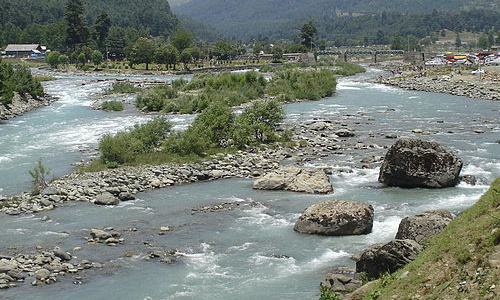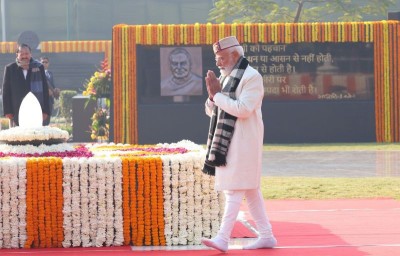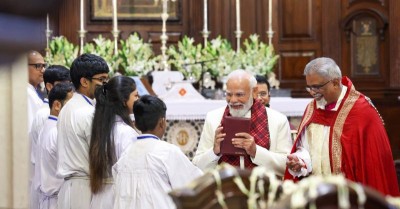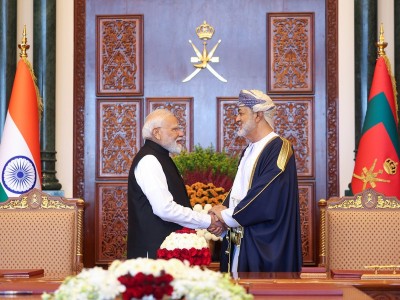
J&K: Dangers Lurk behind Democratic Triumph
For the third consecutive time, the electorate in Jammu and Kashmir (J&K) has thrown up a hung Assembly. The People’s Democratic Party (PDP), with 28 seats in an 87 seat Assembly, has emerged as the single largest party, followed by the Bharatiya Janata Party, with 25 seats; the National Conference with 15; the Indian National Congress, with 12 seats; the Jammu & Kashmir People's Conference with two; and the Jammu And Kashmir People Democratic Front (Secular) and Communist Party of India (Marxist), 1 seat each; three seats went to Independents. Unsurprisingly, hectic parley and consultations, between the major political formations and independent candidates on the issue of Government formation are underway at the time of writing. Results for the 2014 State Assembly Elections were declared on December 23, 2014.
Despite the ambivalence of the outcome, there was a clear message of the people’s growing faith in democracy, with approximately 65.2 per cent of the State's registered voters exercising their franchise. The elections, conducted in five phases between November 25 and December 20, saw the highest turnout of 76 per cent during the last phase (on December 20), while the lowest turnout of 49 per cent was recorded in the fourth phase (on December 14). Voter turnout during first (November 25), second (December 2), and third (December 9) phase, stood at 71.28, 72.1, and 58 per cent, respectively. In terms of number, a total of approximately 4,733,059 voters out of 7,259,293 registered voters cast their vote. Significantly, 831 candidates, 803 men and 28 women, were in the fray for the 87 Assembly seats spread across the State's 22 Districts.
Voting percentage varied considerably. Significantly, 17 constituencies recorded 80 per cent or more polling; another 46 constituencies recorded 60 per cent or more polling; voting percentage in seven constituencies stood over and above 50 per cent. 17 constituencies recorded less than 50 per cent turnout – seven of them registering less than 30 per cent polls.
J&K is administratively divided into three parts – Jammu Division, Kashmir Division (also known as the Valley) and Ladakh Division. Out of 46 constituencies in the Kashmir Division, where the separatist and terrorist constituency remains relatively strong, 29 registered more than 50 per cent voting, including two that recorded more than 80 per cent - Charar-i-Sharif (82 per cent) and Sonawari (80.10). Another 21 of these constituencies recorded polling of 60 per cent or more. All the Assembly constituencies of the Jammu and Ladkah Divisions recorded turnouts of over 60 per cent, with the exception of Kargil, which recorded 59.82 per cent. Several of the constituencies in Jammu Division had, in the past, also recorded a strong presence of terrorists and separatists.
All the seven constituencies which recorded less than 30 per cent turnout fell under the Srinagar Parliamentary Constituency, which had suffered the most during the devastating September 2014 floods, reaffirming the fact that the State Government had failed to reach the people in the aftermath of the deluge, and the voters had chosen to punish their politicians.
Voting percentage during the 2008 State Assembly elections stood at 61.16 per cent, as against 43.70 per cent in 2002, and 53.92 in 1996, demonstrating a steady consolidation of the democratic constituency.
Crucially, moreover, despite sustained provocation from across the border, the 2014 elections remained almost violence-free. None of the 87 constituencies which went to polls recorded a fatality on Election Day, and just one fatality was recorded in a constituency other than that were being polled on one of these five days, December 20, when terrorists killed a sarpanch (head of a village Panchayat, village-level local self-government institution), identified as Ghulam Ahmed Bhat (65), in Sopore town of Baramulla District. Sopore had gone to polls during the third phase, on December 9. Indeed, Vinod Zutshi, one of the Deputy Election Commissioners of India, observed, "It has been the highest turn-out in the last 25 years. This has been a historic turn-out in the current elections... unprecedented and totally peaceful."
This was despite Islamabad’s desperate campaign to escalate terrorist violence, following the high voter turnout during the first phase of elections, to disrupt the poll process. According to partial data, compiled by the South Asia Terrorism Portal(SATP), between November 25 and December 20, 2014 [voting days], a total of 46 persons, including 11 civilians, 16 Security Force (SF) personnel, and 19 terrorists lost their lives in terrorism-related incidents across the State. This period also witnessed four major incidents (each involving three or more fatalities), including two suicide attacks.
On November 27, 2014, terrorists who had reportedly been infiltrated across the border under covering fire by Pakistani Rangers, in violation of the Ceasefire Agreement (CFA), carried out a suicide attack targeting an Army Base Camp in the Arnia sector of Jammu District, killing five civilians and three SF personnel. The four attackers were also killed.
Again, on December 5, a group of heavily armed terrorists who had been infiltrated from across the border, carried out a suicide attack targeting the Army’s 31 Field Regiment Ordnance Camp located at Mohra, near the Line Control (LoC), in the Uri sector of Baramulla District. In the ensuing gunfight, which lasted over six hours, 11 SF personnel, including Lieutenant Colonel Sankalp Kumar, and six terrorists, were killed. December 5, in fact, recorded four coordinated attacks by terrorists, which resulted in at least 21 fatalities, including 11 SF personnel, eight terrorists and two civilians. It was the highest fatality figure for a single day since May 23, 2004, when at least 30 persons, including 19 Border Security Force (BSF) personnel, six women and five children, were killed in an Improvised Explosive Device blast at Lower Munda, near Qazigund, on the Srinagar-Jammu highway.
Further, Islamabad-backed J&K separatist formations working directly under the Inter-Services Intelligence (ISI), Pakistan’s external intelligence agency, had again called for a boycott of the polls, and these calls were backed by threats from terrorists groups operating out of Pakistan. The nexus between the separatists and terrorists was visible, for instance, in a statement by Mohammad Yusuf Shah akaSyed Salahuddin, Hizb-ul-Mujahideen (HM) chief and chairman of the Pakistan occupied Kashmir (PoK)-based Muttahida Jehad Council (MJC], United Jehad Council), who released a statement on November 14, 2014, declaring, "People who will vote in the coming elections will be considered as traitors who sell the blood of martyrs." He had urged the separatists, mainly the All Party Hurriyat Conference (APHC), to launch a door-to-door poll-boycott campaign, which they did, though some have questioned their enthusiasm thereafter. With widespread participation of voters during first phase of the elections, Yusuf Shah found his own constituency wandering away, and stated, "The militant leadership believes participation in the polls is betrayal with the sacrifices (sic). But whatever decision is taken by the Hurriyat over the issue, we will abide by it."
Earlier, the State had also participated in the five-phase General Election for India's Parliament, between April 10 and May 7. The voting percentage during these polls was 49.72, a significant improvement over 2009 General Elections, at 39.70 per cent, and the 2004 Election, at 35.20 per cent. As with the Assembly polls of November-December 2014, the April-May 2014 General Elections were also almost peaceful. According to SATP data, between April 10 and May 7 (voting days), the total terrorism-related fatalities were 13, including four civilians, three SF personnel and six terrorists. Out of six parliamentary constituencies, only Anantnag recorded a killing on Election Day on April 24, when a polling official was killed and another five persons were injured when unidentified gunmen attacked them at Nagabal in Shopian District, within the constituency.
The saga of democratic consolidation was reinforced when, after 33 long years, the State conducted village Panchayat elections in a peaceful environment between April 13 and June 27, 2011. A staggering 79 per cent of the electorate exercised their right to vote in those elections, demonstrating a dramatic deepening of democracy in the State, as a result of the improved security scenario, as compared to era of terrorist ascendancy in the State. At the peak of the Pakistan-backed terrorist campaign, J&K had recorded a total of 4,507 fatalities in terrorism related incidents in a single catastrophic year, 2001.
However, lingering irritants continue to throw up new challenges. Terrorism related fatalities, which had declined continuously, year on year, since 2002, to record a low of 117 in 2012, have seen an increase since, with 181 killed in 2013, and 193 fatalities already recorded in 2014 (till December 28). Significantly, fatalities among civilians increased by 60 per cent, from 20 such fatalities in 2013, to 32 in 2014. Nevertheless, other parameters of violence, including major incidents, suicide attacks and explosions have remained more or less at the same level in 2013 and 2014. In 2014, the number of major incidents stood at 21, resulting in 107 deaths, as compared to 22 such incidents, resulting in 108 deaths, in 2013. Similarly, 2013 recorded three suicide attacks resulting in 20 deaths, while 2014 recorded two such attacks, resulting in 29 fatalities. The number of explosions increased from 12 in 2013 to 14 in 2014, with corresponding fatalities at four and six respectively. On a comparative, 2012 had recorded just 10 major incidents resulting in 45 deaths, and the last of suicide attacks in the State, prior to 2013, were in 2010. The year witnessed a single suicide attack resulting in four deaths, including one civilian, a Policeman and the two suicide attackers (who were killed by the Police).
Even the number of Districts from where killings were reported remained almost the same between 2013 and 2014 – 14 and 13, respectively. In 2014, the maximum number of fatalities were reported from Kupwara District (61), followed by Pulwama (36), and Baramulla (31). In 2013 too, Kupwara had recorded the highest fatalities (67). Significantly, however, no civilian fatalities were inflicted in Kupwara during these two years. In terms of civilian fatalities in 2014, Jammu and Pulwama Districts recorded the highest, at eight each, followed by five in Baramulla and three in Samba. The highest SF fatalities was recorded in Baramulla (14), followed by Kupwara (10) and Pulwama (9).
Among the most visible of irritants, exposing the sustained deceit and hostility of the Pakistani state, is the continuous turbulence along the International Border and Line of Control (LoC). According to the Union Ministry of Home Affairs (UMHA), at least 130 infiltration attempts were made from the Pakistani side in 2014, till October, and of these, 45 occurred in the preceding three months alone. Similarly, a total of 545 incidents of violation of the Cease Fire Agreement (CFA, 2003) occurred along the LoC and International Border were reported in 2014, till November 25. Of these, 424 were reported between August and November 2014 (till November 17), alone. According to partial data compiled by the South Asia Terrorism Portal (SATP), at least six infiltration attempts have been reported since November 1, 2014, and there have been eight CFA violations after November 25, 2014, (data till December 28, 2014). The number of infiltration attempts and CFA violations in 2013 stood at 277 and 347, respectively.
Meanwhile, the drawdown of International Forces from Afghanistan has been completed, and there are apprehensions that India’s border with Pakistan may experience increasing volatility in the proximate future. More effective measures to the border and LoC will be necessary if the dramatic gains of the past years are to be reinforced and advanced further. Several steps have been taken in this direction, and these have significantly reduced the number of successful infiltration attempts from the Pakistani side. As against 100 terrorists estimated to have infiltrated through 2013, 60 are believed to have got through in the current year, according to an August 31, 2014, report.
The reversal, albeit relatively small in comparison to the peak phase of terrorism in J&K, of trends in fatalities in the State is a warning that there is no room for complacence, and that the price for political and administrative mismanagement can be unacceptable, as it has been in the past. The Assembly Elections have created new opportunities and aroused great hope in the State, even as they have eroded the credibility and support base of the separatist constituency. India's and particularly J&K's tragedy in the past has often been that great hope has been followed by great disappointment and consequent anger, feeding the cycle of militancy, and whetting the appetite of terrorist groups and their state handlers in Pakistan for greater violence. It remains to be seen whether the fractured mandate of 2014 will yield a greater stability in this troubled province, and whether the parties will, in fact, deliver on the promise of 'good governance' that lay at the heart of election campaigns this time around.
Support Our Journalism
We cannot do without you.. your contribution supports unbiased journalism
IBNS is not driven by any ism- not wokeism, not racism, not skewed secularism, not hyper right-wing or left liberal ideals, nor by any hardline religious beliefs or hyper nationalism. We want to serve you good old objective news, as they are. We do not judge or preach. We let people decide for themselves. We only try to present factual and well-sourced news.







